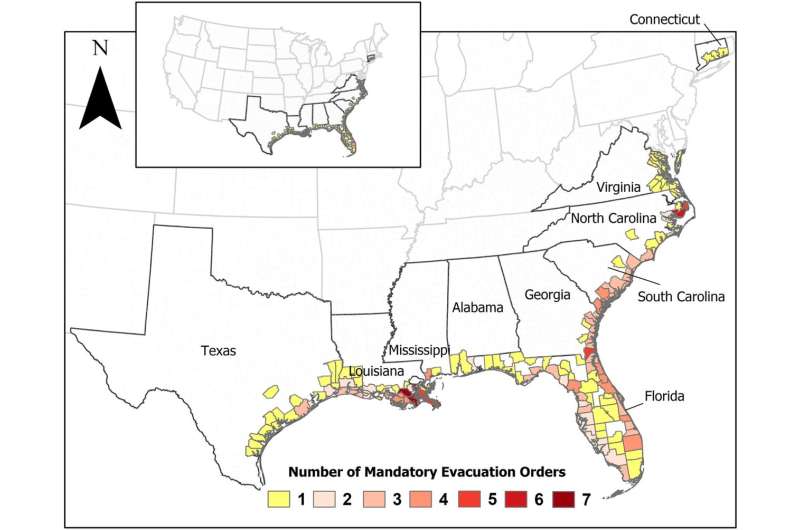This article has been reviewed according to Science X's editorial process and policies. Editors have highlighted the following attributes while ensuring the content's credibility:
fact-checked
peer-reviewed publication
trusted source
proofread
Q&A: Creators of first-ever hurricane evacuation order database say it may hold keys to future readiness

A team of University of Virginia researchers has released the first-ever database of hurricane evacuation orders in the United States. By examining what has worked (and hasn't) in the face of oncoming hurricanes, leaders and government officials can increase community resilience, create better policy, and ultimately, reduce loss of life.
The work is published in the journal Scientific Data.
The project teamed Majid Shafiee-Jood and Negin Alemazkoor with Harsh Anand, an engineering doctoral candidate, from the School of Engineering and Applied Science. The trio spent countless hours gathering all nationwide public-facing evacuation orders and created a database that can be used by researchers and practitioners to measure the effectiveness of hurricane evacuation policies.
The Institute connected with Anand and Shafiee-Jood, an assistant professor of civil engineering and systems and information engineering, to learn more about the impact of this research.
What did you and your team create? What information is in this database?
We created the first comprehensive database of hurricane evacuation orders in the United States—the HEvOD (Hurricane Evacuation Order Database).
Our database includes evacuation orders issued by official state and local agencies in response to hurricanes that impacted the United States between 2014 and 2022 (25 hurricane events in total). We collected archival orders from multiple sources, including official websites and social media accounts of local and state governments and government agencies, as well as news platforms.
Corresponding to each evacuation order, we included information on the type of the order (mandatory or voluntary), the announcement date and time of the order, the effective date and time of the order (where applicable), and the areas that were the target of the order for evacuation. The database also includes information regarding the State of Emergency as declared by the governors in response to the events.
We were driven by the recognition that while evacuation orders are crucial for public safety during hurricanes, there was no database of historical hurricane evacuation orders.
As we move into more intense hurricane seasons due to a changing climate, helping our communities be more resilient and potentially protect themselves in the face of incoming hurricanes is going to be valuable.
Why wasn't there such a database already in existence?
From experience, it is very challenging to compile such a database. We had to navigate through various complexities.
For instance, evacuation laws and policies vary widely across states. States differ on who has the legal authority to order mass evacuations (such as local jurisdictions and governors). State and local entities also differ in how they communicate the details of evacuation orders, including order type and geographic size of the location.
Additionally, a wide range of platforms are typically used to disseminate orders (press conferences, press releases, social media, news media, and public outlets). This makes the process of data collection and verification challenging and time-consuming.
How can people access it?
HEvOD is publicly accessible through LibraData, the University of Virginia's open-access repository, and can also be accessed from our website.
How can this database be useful to the government?
Local and state government officials can use our database to assess the effectiveness of evacuation orders issued during past hurricane events and plan more effective strategies for future emergencies. By understanding where, when, and how evacuations have been ordered in the past, emergency management officials can optimize their response plans and communication strategies, enhancing public safety and community resilience.
What potential does this database hold for future use?
The primary aim is to provide the foundation for a detailed analysis of evacuation strategies and procedures to determine their effectiveness and to identify areas for improvement. This can improve policy decisions, leading to more targeted and timely evacuation orders, better resource allocation, and ultimately, reduced loss of life during hurricanes.
We also hope to identify trends and patterns that could predict the need for evacuations more accurately.
Additionally, HEvOD allows integration with other data sources, which we believe will be exciting to other disciplines of research. For example, social scientists, urban planners, and environmental scientists can analyze evacuation responses in diverse communities.
Did anything surprise you about the information?
Yes, a surprising finding was the significant variation in how different jurisdictions implement and communicate evacuation orders. While some counties are governed by state authorities, others are more ad hoc based on local emergency management authorities. This underscores the complexity of creating a standardized system for emergency evacuations and highlights the importance of having a centralized database to capture these variations comprehensively.
What are the next steps, now that you have this information?
We have already started using HEvOD to answer some outstanding research questions on hurricane evacuation decision-making.
For instance, in one study, we are quantifying the effectiveness of mandatory hurricane evacuation orders issued in response to Hurricane Dorian (2019) in Florida.
In another study, we are comparing the relationship between evacuation orders and evacuation patterns in the cases of Hurricane Ian (2022) and Hurricane Idalia (2023).
Our goal is to update and expand the HEvOD database annually after each hurricane season. To keep it relevant and effective, we welcome contributions and collaboration. Additionally, our website features a section where users can assist by adding missing data or correcting errors, further improving the quality and utility of the database.
More information: Harsh Anand et al, HEvOD: A database of hurricane evacuation orders in the United States, Scientific Data (2024). DOI: 10.1038/s41597-024-03100-x
Journal information: Scientific Data
Provided by University of Virginia




















